During the Korean War, South Korean women prayed and wailed as they identified family members killed by North Korean troops in 1953. Trapped as prisoners in a cave near Hamhung (the second largest city in North Korea), they suffocated a number of South Korean men to death. A foul smell of decomposing corpses surrounded the bodies, and family members covered their noses and mouths to watch.
In the Democratic People's Republic of Korea (DPRK), citizens were subjected to very strict controls on all activities from 1948 to 1987. Information about the regime's purges, executions, and forced labor camps was closed to the rest of the country. Civilian massacres were suspected through analysis of publications and documents of defectors, escapees, agents, refugees from the Korean War, and South Korea. Some 710,000 to 3.5 million people were killed, with estimates ranging from 1.6 million. Thought control over the people of North Korea has obscured deep suspicions of a massive civilian genocide. North Korea's social polarization and humanitarian crimes such as expulsions, labor camps, and executions.
In the very bloody Korean War, some 2.55 million people were killed in North and South Korea. The number of executions and death sentences in the labor camps, concentration camps, purges, agrarian reforms, and large-scale follow-on military operations that completely dominate North Korea is unknown. The political murder of thousands of people by the Communist Party is certain.
Some estimates of specific massacres or killings have been made. When North Korean troops invaded South Korea during the Korean War, followed by the Communists, they systematically massacred former South Korean government officials, anti-Communists, and other citizens suspected of being hostile to the Communists. As North Korean troops withdrew from the south to the north, the killings intensified. Daejeon and Wonju are estimated to be among the deadliest. The ROK Foreign Intelligence Service has a minimal estimate of the South Koreans who were killed.
It is difficult to determine the number of South Korean (Republic of Korea) POWs killed by North Korean forces. In all, the communists claimed to have captured 70,000 South Korean soldiers, but only about 8,000 have returned. The North Korean military has killed between about 5,000 and 12,000 South Korean POWs, and another 5,000 to 6,000 American POWs.
North Korea has forced about 400,000 South Koreans to join the North Korean army by charging the POWs as criminals. The North Korean military ordered South Koreans to perform the most dangerous missions and combat. North Korean troops killed about 350,000 people during the Korean War, almost two and a half times more than the number of South Korean soldiers killed. About 225,000 civilian killings were executed by North Korea. Overall, the North Korean communists underestimated the killing of nearly half a million South Koreans, including North Korean civilians, during the Korean War. In reality, the death toll amounted to nearly 775,000 civilian killings.
With the exception of the Korean War, there is little estimate of the civilian killings within North Korea. Labor camps and concentration camps were the most recent estimates of the number of prisoners in the camps. It is not known how many of the prisoners died annually. In the North Korean camps, the number of prisoners killed ranged from about 71,000 to about 707,000, or about 6,700 per year.

